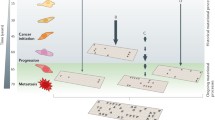Abstract:
The mutator phenotype theory of carcinogenesis suggests that genetic instability is an early and essential part of tumour development. This instability provides for substantially random cell-to-cell genomic variation (genomic heterogeneity) to arise among cells of individual tumours. Genetically unstable cells then produce 'successful' clones of cells with the necessary mutations for malignant behaviour. In a previous paper (Bignold L. P., Cell. Mol. Life Sci. 2002; 59: 950–958), it was pointed out that a population of cells which is heterogeneous for behaviour-related genes may well also be heterogeneous for morphology-related genes. This would result in cellular pleomorphism among cells of individual tumours, and so explain this almost universal characteristic of solid malignancies.¶If the concept of random genomic variability applies fully to the histopathology of tumours, then most tumours should show a mixture of neoplastic features, especially nuclear atypia, loss of specialised function (such as loss of production of mucus by glandular cells) and invasiveness. However, occasional lesions might be expected to occur which show these characteristics independently. That is, lesions should exist which exhibit one or two of the three characteristics of neoplasms without the other(s).¶This paper identifies, among human tumours, lesions which show independence of these characteristics. Two of the examples discussed are a Bowenoid solar keratosis that shows severe nuclear atypia, but no apparent loss of specialisation and no invasiveness. On the other hand, anaplastic small cell carcinoma of the lung often exhibits marked loss of differentiation, very aggressive invasion and metastasis, but little nuclear pleomorphism.¶These examples are considered to provide further support for the importance of the mutator phenotype to the pathogenesis of neoplasia.
Similar content being viewed by others
Author information
Authors and Affiliations
Additional information
Received 26 August 2002; received after revision 7 October 2002; accepted 9 October 2002
Rights and permissions
About this article
Cite this article
Bignold, L. The mutator phenotype theory of carcinogenesis and the complex histopathology of tumours: support for the theory from the independent occurrence of nuclear abnormality, loss of specialisation and invasiveness among occasional neoplastic lesions. CMLS, Cell. Mol. Life Sci. 60, 883–891 (2003). https://doi.org/10.1007/s00018-003-2226-5
Issue Date:
DOI: https://doi.org/10.1007/s00018-003-2226-5




